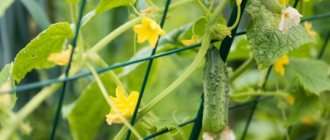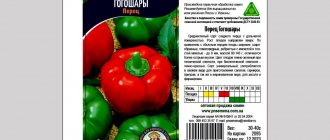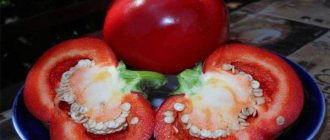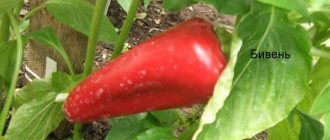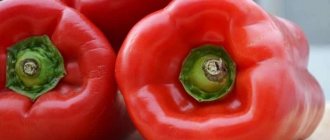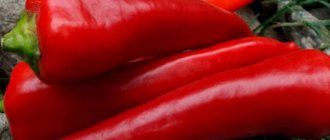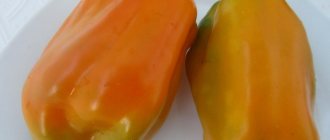History of creation
This bell pepper was bred at the Moldavian Research Institute by experienced breeders who experimented with shape and taste. They created a new variety, in which the fruits have a special structure: they resemble flattened balls or small pumpkins.
The breeding group includes several varieties. Ratunda, according to scientific taxonomy, is precisely a variety type, and not a variety, but for ordinary gardeners and summer residents this is not important, so the variety is usually called simply a variety.
Pepper received high marks from experts and quickly became recognizable due to its characteristics. Nowadays it can often be found not only on farms, but also in the gardens of ordinary people.
Related article:
Spicy and its varieties: 5 types of hot peppers that will add piquancy to dishes
Reviews about the Ratunda pepper variety
Subject to planting and care standards, Ratunda pepper always meets the gardener’s expectations, hence its popularity.
- Alexandra Kalinina : “The Ratunda variety is mid-season. Planted peppers usually ripen in 125-130 days, but the time spent on care is fully repaid by the delicious peppercorns. The harvest is usually rich. The pepper is beautiful and looks very nice in jars. And even after heat treatment it retains its color and shape. I usually use it for canning. And I even once made stuffed peppers out of it. Due to its small size, it turned out to be small, but it was incredibly tasty!”
- Timur Laptev : “The pepper is very good for sale. Size, shape, taste, color and even aroma - everything attracts buyers. I grow 5 varieties for sale, but it is the Ratunda pepper that is usually sold out first. The costs of cultivation fully pay for themselves, so the variety is profitable.”
- Margo Zolotko : “We grow the Ratunda pepper variety year after year. I like it for its taste (moderately sweet), appearance, and fleshy walls. It retains taste in dishes and is stored for quite a long time. And growing it is not very problematic, the main thing is to water it on time and ensure normal temperature (shade it from the sun in hot weather).”
Description
Bell pepper with sweet pulp. The main distinguishing feature is the flattened shape of the fruit. Belongs to the mid-season group: 125-130 days after sowing they begin to harvest.
At the stage of technical maturity, the peel is dark green. Later it becomes rich red. Up to 15 ovaries are generated on one bush. As a rule, they are all preserved and matured.
When cultivating, you need to take into account that the variety is prone to cross-pollination, so all varietal characteristics may be disrupted if another variety grows nearby: the pulp becomes bitter, the specific shape of the fruit is disrupted, etc.
The plant is short: it does not grow higher than 60 cm, and the average height is 40-45 cm. The fruits are large - up to 100 g. The fiber is juicy, but dense, the wall thickness is 5-10 mm. The seed chambers are large and contain many seeds inside. In rare cases, interchamber septa may produce slight bitterness.
Features of growing seedlings
Source
Traditional places for storing winter supplies are a cellar or basement. However, theoretically, conservation can be done in any place where a dry microclimate prevails and stable temperatures of 4... 7°C.
All preservation should be protected from high humidity, low temperatures and prolonged exposure to direct sunlight. Pickled Ratunda pepper is one of the favorite delicacies on the table in winter: its slightly spicy, sweetish taste, delicate aroma and bright appearance are reminiscent of summer.
Plants love moisture, so watering is recommended at least once a week. If the weather is hot and dry, water the peppers every 3 days. Moistening is carried out only with warm water at the root. Each bush needs to spend up to 1-2 liters of water. When the ovaries are formed, watering becomes more frequent. The main thing is to ensure that there is no waterlogging. This can cause illness.
Top dressing
It is recommended to fertilize the plants three times during the season. 2 weeks after planting the seedlings, fertilizers with superphosphate are applied, 40 grams of which are diluted in 10 liters of water. You can use a solution of wood ash, a kilogram of which is diluted in a bucket of water.
Next time, fertilizers are applied when the ovaries appear. It is recommended to fertilize with bird droppings or manure.
The next feeding is carried out by organics during the period of fruit growth.
- Proper watering. Pepper can be watered exclusively at the root and only with water that has been warmed up the day before. If there is a lack of water, plants can shed the ovaries that have already formed, and if there is an excess of moisture, the pepper may get sick.
- Maintaining optimal air humidity. To do this, you need to periodically water the paths or glass of the greenhouse with water. In dry air, pepper can also shed ovaries and flowers.
- Mulching the soil. The roots of the pepper are on the surface of the soil, so loosening can easily damage them. An alternative solution is mulching. So, air exchange in the soil is maintained and the roots are intact.
Pepper garter. To prevent branches from breaking, they must be constantly tied up.
If you follow the basic rules of care, anyone, even a novice gardener, can get an excellent harvest of Ratunda pepper.
Main characteristics
Ratunda is grown both in greenhouses and greenhouses, and in open ground. The seedling method is more suitable, since with it the germination of seeds is an order of magnitude higher.
Related article:
When to fertilize pepper seedlings
This pepper is valued for its excellent appearance: the peel is thin, but with a waxy coating. The pulp has a pleasant vegetable aroma, which remains fresh throughout storage.
Ratunda is known for its high content of useful substances such as ascorbic acid and vitamin P. It is especially recommended in the diet of people with blood disorders.
Before starting cultivation, it is worth considering that the variety needs fertile soil. Poor soils must be prepared in advance. When grown on a suitable type of soil, the taste characteristics reach their peak: tasters note honey notes, making the variety almost dessert-like.
Varieties
Based on the species, several varieties have been bred, which differ slightly in characteristics. Among them, you can choose the type that suits your specific request perfectly.
Kolobok
Walls with a high content of juice in the cells. This allows you to use Kolobok for preparing fresh or canned juices. The bush is very compact - 35-40 cm. This makes growing easier, since the plant does not suffer from winds, and the branches do not break during heavy rains.
Related article:
When and how to plant peppers in the ground
Kolobok is a relatively early-ripening variety: the harvest begins within 100 days after sowing.
Merishor
A heat-loving variety, it is grown in open ground mainly in Moldova and Ukraine, and in other regions it most often requires a greenhouse approach. Compact plants, high productivity of plantings is achieved due to dense arrangement.
The color of the peel is not as rich as that of most other varieties of Ratunda; there is a yellow color.
Ruby sweetness
The peppers are large, up to 150 g. The plant rises up to half a meter above the ground, the shape of the crown is spreading. The yield of Ruby Sweetness is slightly lower than that of other varieties from this group, but the taste properties are even better.
Olenka
The variety is designed for film shelters, since Olenka is a heat-loving crop. The main feature is incredible productivity: from 1 m2 you can harvest up to 9 kg of high-quality fruits. In order for the potential to fully manifest itself, it is necessary to apply mineral supplements.
Related article:
How to grow pepper seedlings from seeds at home, step-by-step instructions
Ratunda Israeli
A variety that has enhanced all the main characteristics of the variety. The peel is dark cherry in color, and the harvest begins to ripen within 100-120 days after planting.
The beauty of this species is that it sets fruit well and grows well on poor soils. In addition, it is drought-resistant and not susceptible to most specific diseases.
How to care for Ratunda sweet peppers
We recommend reading our other articles
- Zucchini in tomato
- Varieties of cucumbers for open ground
- Why does a cow give little milk and what to do?
- Recipes for lecho with carrots
Water the Ratunda pepper in the evening with warm water directly under the root.
After planting the seedlings, you need to water the peppers and leave them to take root and take root for about a week. During this period, only watering is observed among the mandatory standards of care, because all other procedures can put the plants under even greater stress and negatively affect the development of the bushes. But when the plants take root, they are provided with complete care.
Water the Ratunda pepper in the evening with warm water directly under the root. It is worth making sure that the soil does not dry out, but it should not be swampy either. Usually, each bush uses up to 3 liters of water per watering, but if watering is frequent, then you can water it with a liter of warm water, this will be enough.
Interesting! To prevent plants from shedding formed ovaries, it is worth irrigating from time to time.
- Ratunda pepper grows up to 60 cm. This is not a very high height, but due to the heaviness of the fruits, they can bend to the ground and even break in strong winds, so a garter will not do any harm. The pegs are simply installed between the plants and the stems of the grown bushes are tied to them.
- Weeding in the case of sweet peppers can be harmful, because its root system forms a whole network in the upper layers of the earth. But to prevent the soil from drying out and becoming crusty, it is worth mulching it with straw or something similar.
- If the outside temperature does not drop below +35 degrees for a long time, the plants need to be darkened.
- Fertilizing with complex mineral fertilizers, compost or humus solutions will increase the yield by 1.5-2 times.
- Pests on peppers are not uncommon. For aphids, spider mites and some other insects, bushes are treated with insecticides such as Karbofos or Keltan. Sweet peppers rarely get sick, but if you do not follow the watering norm, rot may develop.
Productivity
On average, about 5 kg of fruits are harvested from 1 m2 under normal conditions. With very dense plantings, this figure increases, but this approach is impractical. The fact is that with dense plantings, the costs of seedlings and fertilizer increase disproportionately, since the root system of each plant begins to experience a deficiency of nutrients, and intensive feeding is needed to replenish it.
Area of application of fruits
Ratunda is a universal variety. In a state of technical maturity, it is ideal for stuffing. Both unripe and ripe fruits are perfect for transportation. They are stored for a long time in cool conditions without loss of quality.
Related article:
Sweet pepper Pinocchio
The ripe pulp is used in salads and can be heat treated: frying, stewing, boiling, steaming. Also suitable for quick freezing, and after defrosting it does not lose its shape or run off.
Harvest
Ratunda peppers are harvested as the crop ripens.
Ratunda peppers are harvested as the crop ripens. Once the pepper has reached technical maturity and acquired a green color, it can be harvested, but if left for another 2-3 weeks, it will turn deep red - it will acquire its natural color.
The harvested crop can be used to prepare a variety of winter preparations (pickling, drying, freezing, fermenting). Ratunda pepper can also be used for preparing first and second hot courses, cold appetizers, salads, and sauces.
Diseases and pests
Most often, Ratunda suffers from various diseases when grown indoors. The most common problem is aphids. Treatment with mineral fertilizers high in phosphorus and potassium helps.
It can also be affected by spider mites, thrips, Colorado potato beetles, etc. In this case, insecticides and acaricides are used. Sometimes an attack by slugs and mole crickets is possible. They are fought with the help of special drugs.
In general, this pepper is considered resistant to specific diseases that affect this crop.
Advantages and disadvantages
The variety has become widespread because it has many advantages:
- high taste characteristics;
- nutritional value, rich in vitamins, organic acids and minerals;
- relative ease of cultivation;
- resistance to diseases such as Alternaria, tobacco mosaic, etc.;
- excellent transportability;
- keeping quality and good marketability.
Related article:
A box of peppers from one plant without much effort
Among the disadvantages are the large number of seeds in the internal chambers and the demanding temperature conditions at the time of seed germination.
Planting and care
For successful cultivation, you need to know the main principles of pepper care and the characteristics of this variety.
Interesting! Growing big and tasty peppers
Sowing
Seed preparation begins at the end of February. For quick germination, soaking for a day is allowed. Then they are etched in a weak solution of manganese for 10-20 minutes. For sowing, you need a fertile substrate that will allow moisture to pass through well. You can purchase a ready-made mixture or prepare it from humus, turf and coarse quartz sand in a ratio of 3:3:1.
After about 2 weeks, the first seedlings appear. For successful germination, a special temperature regime is required - 23-25°C. A week after the seedlings appear, the temperature must be lowered to 17°C, otherwise the sprouts will begin to stretch and become too thin.
After 2-3 weeks, the first feeding is carried out. The dosage of fertilizers at this moment is reduced by 3 times from the specified norm.
At the stage of 2 real sheets, picking is carried out. The roots are very fragile, so this must be done with great care, trying not to damage them.
Related article:
Take into account the whims - you will receive a harvest! Pepper Growing Tips
Throughout the entire cultivation of seedlings, it is necessary to ensure a normal light regime: supplementary lighting should be organized in such a way that the daylight hours are at least 14 hours.
1.5 weeks after picking, a second feeding is performed. This time take ½ dose of fertilizer. You can prepare your own solution from 1 tsp. urea and 1 tbsp. l. superphosphate per 10 liters of warm water.
The dissolution time of superphosphate in water is one day, so the solution is prepared one day before watering.
Transplanting into a greenhouse
Ratunda is planted in a permanent place when the first bud appears on the plant. The recommended arrangement is 25x50 cm. Young bushes are placed in moist soil. Drying out at the time of rooting should not be allowed, but waterlogging is also detrimental to young plants.
Outdoor care
In warm regions, seedlings are planted in the garden in the last weeks of May, and in northern regions - in early June. You need to choose a garden bed in a quiet place, without winds, with normal lighting. Before planting, you should add nutrients per 1 m2:
- 35 g of phosphorus-potassium mixtures;
- 20 g of nitrogen fertilizer.
Related article:
Secrets of a huge pepper harvest
After this, the earth is dug up to the depth of a spade bayonet.
Planting pattern in open ground – 40x60 cm.
For a week after transplanting, it is necessary to moisten the soil well, but waterlogging is prohibited, otherwise the development of fungal flora begins. For normal growth, it is recommended to mulch the soil: this will allow you to maintain the desired level of humidity for a long time and prevent the appearance of weeds.
Bush formation
Ratunda needs plant shaping. After the development of the first branch, all stepsons that will appear lower over time will need to be cut off. The first bud is also removed to initiate rapid flowering. Further, throughout the entire growth, when paired shoots appear, the smaller and weaker shoots are removed, leaving the powerful one.
From mid-August, the top of the bush is pinched to stop further growth. This will preserve the strength to ripen all the peppers that have already set at this point. It is recommended to pick the first fruits green to reduce the load on the plant. Further, the harvest from Ratunda is carried out once every 1 or 1.5 weeks.
Related article:
Growing big and tasty peppers
During active flowering, it is important to open the greenhouse more often for ventilation, because without active air exchange, pollination does not occur.
Winter recipes
Winter preparations from Ratunda are not much different from those in which bell peppers are used. The most popular recipes require preservation. This way it is possible to preserve the product for a long time.
To preserve beneficial microelements, peppers are frozen. At the same time, it does not lose its taste and does not spread after thawing. The fruits are cut into arbitrary shapes, dried and packaged in bags for freezing. Ratunda is also prepared for stuffing. To do this, remove the stalk with seeds and put the peppers in bags.
Fleshy fruits are suitable for preparing lecho, adjika, salads with the addition of carrots, eggplants, tomatoes, onions and garlic. Unusual sweet marinades with heat and spices highlight the rich taste of pepper.
Pepper in tomato juice
To prepare the preparation you will need the following ingredients:
- pepper – 6 kg;
- tomato juice – 4 l;
- sugar – 2 tbsp;
- refined sunflower oil – 1 tbsp.;
- vinegar 9% – 1 tbsp.;
- salt – 4 tbsp. l.;
- peppercorns and bay leaf to taste.
Cut the peppers into halves and remove the seeds. Mix the ingredients for making syrup in an enamel bowl and bring to a boil. Submerge the peppers in the liquid and cook for five minutes. Transfer the fruits into pre-sterilized jars, fill with syrup and roll up with a key. Turn the jars upside down and wrap them up.
Sweet pepper in honey-oil marinade
Marinade with honey will add piquancy to the pepper. The snack is eaten immediately after preparation or rolled into jars for the winter.
To prepare peppers in oil you will need the following products:
- pepper – 1 kg;
- honey – 5 tbsp. l.;
- water – 100 ml;
- vinegar 9% – 100 ml;
- vegetable oil – 100 ml;
- sugar – 1 tbsp., l.;
- salt – 1 tsp;
- black or allspice peas.
Combine marinade ingredients in a saucepan and boil for five minutes. Cut the peppers into quarters and cook until darkened, about 7-9 minutes.
Place the fruits in jars and close with screw caps. You can use a seaming wrench and special caps. Turn the jars upside down and wrap them in a blanket.
Advice. Use peppercorns of different colors. This will add a pop of color to your appetizer.
Honey Ratunda in spicy marinade
The marinade with the addition of chili pepper and spices will appeal to spicy lovers.
For the preparation you will need the following ingredients:
- pepper – 1 kg;
- sugar – 1 tbsp. l.;
- salt – 2 dec. l.;
- water – 1.5 tbsp.;
- tomato paste – 3 dess. l.;
- refined oil – 1.5 dess. l.;
- vinegar 9% – 2 dec. l.
Spices for marinade:
- bay leaf – 3-4 leaves;
- garlic – 2 cloves;
- black peppercorns – 12-15 pcs.;
- coriander seeds – 1 tsp;
- cumin – 1 tsp;
- mustard beans – 4 tsp;
- half a chili pepper;
- small dried horseradish root.
Peel the gogoshars from the stalk and seeds, cut into four pieces and pat dry with a paper towel. Mix water, oil, salt, tomato paste, sugar and vinegar for the marinade. Cook over low heat, stirring occasionally, and bring to a boil. Immerse the pepper in the liquid and simmer for 15 minutes.
Pour some spices into the jars, transfer Ratunda and fill with marinade. Close the jars with lids, turn the top upside down and wrap them up.
Ratunda pepper with honey for the winter
The pleasant sweetness of the marinade and the pronounced taste of Ratunda in this recipe will not leave anyone indifferent.
To prepare the preparation for the winter you will need:
- pepper – 1 kg;
- water – 200 ml;
- Refined sunflower oil – 80 ml;
- vinegar 9% - 80 ml;
- sugar – 80 g;
- honey - 1 tbsp. l;
- salt – ½ tbsp. l.;
- garlic – 5 cloves;
- allspice peas – 5 pcs.;
- laurel – 2-3 leaves.
Peel the pepper from seeds and cut into strips. Mix the ingredients for the marinade in a deep saucepan and bring to a boil, at the end add the garlic, passed through a press.
Place the peppers in the marinade and cook for 10 minutes. At first it will seem that there is little liquid, but during cooking the fruits will release juice. Place in sterile jars, close the lids in a way convenient for you, turn the neck down and wrap.
